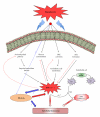Endothelial dysfunction in diabetes mellitus: possible involvement of endoplasmic reticulum stress?
- PMID: 22474423
- PMCID: PMC3299342
- DOI: 10.1155/2012/481840
Endothelial dysfunction in diabetes mellitus: possible involvement of endoplasmic reticulum stress?
Abstract
The vascular complications of diabetes mellitus impose a huge burden on the management of this disease. The higher incidence of cardiovascular complications and the unfavorable prognosis among diabetic individuals who develop such complications have been correlated to the hyperglycemia-induced oxidative stress and associated endothelial dysfunction. Although antioxidants may be considered as effective therapeutic agents to relieve oxidative stress and protect the endothelium, recent clinical trials involving these agents have shown limited therapeutic efficacy in this regard. In the recent past experimental evidence suggest that endoplasmic reticulum (ER) stress in the endothelial cells might be an important contributor to diabetes-related vascular complications. The current paper contemplates the possibility of the involvement of ER stress in endothelial dysfunction and diabetes-associated vascular complications.
Figures



Similar articles
-
PPARδ Is Required for Exercise to Attenuate Endoplasmic Reticulum Stress and Endothelial Dysfunction in Diabetic Mice.Diabetes. 2017 Feb;66(2):519-528. doi: 10.2337/db15-1657. Epub 2016 Nov 17. Diabetes. 2017. PMID: 27856609
-
Diabetes and vascular disease: basic concepts of nitric oxide physiology, endothelial dysfunction, oxidative stress and therapeutic possibilities.Curr Vasc Pharmacol. 2010 Jul;8(4):526-44. doi: 10.2174/157016110791330834. Curr Vasc Pharmacol. 2010. PMID: 19485895 Review.
-
Role of endoplasmic reticulum stress signalling in diabetic endothelial dysfunction and atherosclerosis.Diab Vasc Dis Res. 2017 Jan;14(1):14-23. doi: 10.1177/1479164116666762. Epub 2016 Oct 20. Diab Vasc Dis Res. 2017. PMID: 27941052 Free PMC article. Review.
-
Endothelial dysfunction in diabetes mellitus.Vasc Health Risk Manag. 2007;3(6):853-76. Vasc Health Risk Manag. 2007. PMID: 18200806 Free PMC article. Review.
-
Why does diabetes mellitus increase the risk of cardiovascular disease?Acta Med Indones. 2006 Jan-Mar;38(1):33-41. Acta Med Indones. 2006. PMID: 16479030 Review.
Cited by
-
RhoA/mDia-1/profilin-1 signaling targets microvascular endothelial dysfunction in diabetic retinopathy.Graefes Arch Clin Exp Ophthalmol. 2015 May;253(5):669-80. doi: 10.1007/s00417-015-2985-3. Epub 2015 Mar 20. Graefes Arch Clin Exp Ophthalmol. 2015. PMID: 25791356 Review.
-
Administration of tauroursodeoxycholic acid prevents endothelial dysfunction caused by an oral glucose load.Clin Sci (Lond). 2016 Nov 1;130(21):1881-8. doi: 10.1042/CS20160501. Epub 2016 Aug 8. Clin Sci (Lond). 2016. PMID: 27503949 Free PMC article. Clinical Trial.
-
NLRP3 Inflammasome at the Interface of Inflammation, Endothelial Dysfunction, and Type 2 Diabetes.Cells. 2021 Feb 3;10(2):314. doi: 10.3390/cells10020314. Cells. 2021. PMID: 33546399 Free PMC article. Review.
-
Natural killer cell function, an important target for infection and tumor protection, is impaired in type 2 diabetes.PLoS One. 2013 Apr 25;8(4):e62418. doi: 10.1371/journal.pone.0062418. Print 2013. PLoS One. 2013. PMID: 23638076 Free PMC article.
-
The Role of Endothelial Dysfunction in Peripheral Blood Nerve Barrier: Molecular Mechanisms and Pathophysiological Implications.Int J Mol Sci. 2019 Jun 20;20(12):3022. doi: 10.3390/ijms20123022. Int J Mol Sci. 2019. PMID: 31226852 Free PMC article. Review.
References
-
- World Health Organization, Bode CD. Media Centre-Fact Sheets, Diabetes, 2011, http://www.who.int/mediacentre/factsheets/fs312/en/index.html.
-
- Schalkwijk CG, Stehouwer CDA. Vascular complications in diabetes mellitus: the role of endothelial dysfunction. Clinical Science. 2005;109(2):143–159. - PubMed
-
- Fowler MJ. Microvascular and macrovascular complications of diabetes. Clinical Diabetes. 2008;26(2):77–82.
-
- Grundy SM, Howard B, Smith S, Jr., Eckel R, Redberg R, Bonow RO. Prevention conference VI: diabetes and cardiovascular disease—executive summary: conference proceeding for healthcare professionals from a special writing group of the American Heart Association. Circulation. 2002;105(18):2231–2239. - PubMed
-
- Bakker W, Eringa EC, Sipkema P, Van Hinsbergh VWM. Endothelial dysfunction and diabetes: roles of hyperglycemia, impaired insulin signaling and obesity. Cell and Tissue Research. 2009;335(1):165–189. - PubMed
Publication types
MeSH terms
LinkOut - more resources
Full Text Sources
Medical
Miscellaneous
